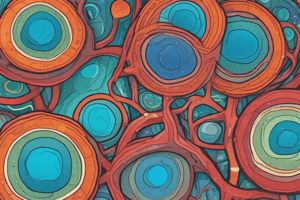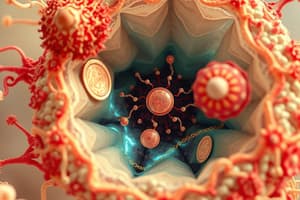Podcast
Questions and Answers
What is the fundamental property that characterizes living things and distinguishes them from nonliving matter?
What is the fundamental property that characterizes living things and distinguishes them from nonliving matter?
- Membrane-enclosed structure
- Specialized function integrated by cell-to-cell communication
- Concentration of aqueous solution of chemicals
- Ability to create copies of themselves by growing and dividing (correct)
What marked a revolution in thinking more than 175 years ago?
What marked a revolution in thinking more than 175 years ago?
- The growth and division of cells
- The concentration of aqueous solution of chemicals in cells
- The discovery of specialized functions of cells
- The establishment of cells as the fundamental units of life (correct)
What distinguishes higher organisms from the simplest forms of life?
What distinguishes higher organisms from the simplest forms of life?
- Being communities of cells derived from a single founder cell (correct)
- Membrane-enclosed structure
- Ability to grow and divide
- Concentration of aqueous solution of chemicals
What is the study of cells and their structure, function, and behavior referred to as in the text?
What is the study of cells and their structure, function, and behavior referred to as in the text?
What is the extraordinary ability possessed by cells according to the text?
What is the extraordinary ability possessed by cells according to the text?
What distinguishes living things from nonliving matter, based on the text?
What distinguishes living things from nonliving matter, based on the text?
What is the main focus of cell biology according to the text?
What is the main focus of cell biology according to the text?
Why is the comparison between a bacterial cell and a frog egg significant?
Why is the comparison between a bacterial cell and a frog egg significant?
What do all present-day cells appear to have evolved from, according to the text?
What do all present-day cells appear to have evolved from, according to the text?
What is the significance of the chemical machinery common to all cells?
What is the significance of the chemical machinery common to all cells?
Why do cells vary widely in their appearance and function?
Why do cells vary widely in their appearance and function?
What distinguishes a typical nerve cell in the brain from other types of cells?
What distinguishes a typical nerve cell in the brain from other types of cells?
How does the size of a frog egg compare to that of a Lactobacillus bacterial cell?
How does the size of a frog egg compare to that of a Lactobacillus bacterial cell?
What does the text suggest about the number of distinct species of living things on Earth?
What does the text suggest about the number of distinct species of living things on Earth?
Study Notes
- All living things, or organisms, are built from cells: small, membrane-enclosed units filled with a concentrated aqueous solution of chemicals.
- Cells have the ability to create copies of themselves through growth and division.
- The simplest forms of life consist of solitary cells.
- Higher organisms, including humans, are communities of cells derived from a single founder cell.
- Every animal or plant is a colony of individual cells, each performing specialized functions integrated by cell-to-cell communication.
- Cells are the fundamental units of life.
- There are up to 100 million distinct species of living things on Earth, and cells vary enormously in appearance and function.
- Animal and plant cells differ, and even cells within a single organism can differ in appearance and activity.
- All cells share a fundamental chemistry and other common features, suggesting they all evolved from a common ancestor.
- Bacterial cells, such as Lactobacillus, are a few micrometers in length, while frog eggs are much larger, with diameters of about 1 millimeter.
- Cells vary greatly in shape, from the enormously extended nerve cells in the brain to the relatively simple bacterial cells.
Studying That Suits You
Use AI to generate personalized quizzes and flashcards to suit your learning preferences.
Description
Test your knowledge about the fundamental properties that characterize living things and distinguish them from nonliving matter. This quiz covers the basic facts about cells and their role in all living organisms.



